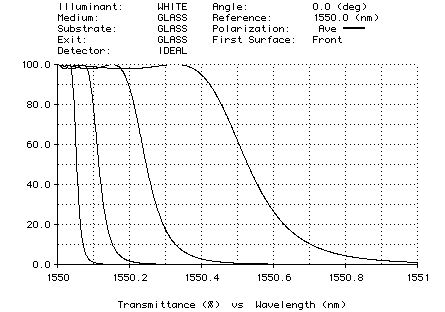A Family of WDM and DWDM Filters
A number of people have asked for a sample WDM filter. This type of bandpass coating is used in the telecommunications industry to control the transmission of multiple laser lines (i.e., channels) through fiberoptic cables. WDM is the abbreviation for Wavelength Division Multiplexing. DWDM means Dense WDM; that is, the spacing between laser wavelengths is denser, allowing the fiber to transmit more information. These filters are usually designed for wavelengths near 1550 nm.
We will consider the following four generations of WDM filters
Spacing (GHz) Spacing (nm) Channels Bandwidth (nm) 400 3.2 8 0.8 200 1.6 16 0.5 100 0.8 32 0.2 50 0.4 64 0.1which shows the center-to-center spacing of the channels in frequency units and wavelength units. As you can see, the denser spacing allows many more channels. The table also shows that these filters must have an extremely narrow bandwidth. (For this type of filter, bandwidth is measured at 1 dB, which is approximately the 79.4% transmittance level.) To minimize the interference between channels, there is also a requirement to block the transmission of adjacent channels. This is typically 30 dB (i.e., 0.1%) at the position of the next channel.
We introduce the following family of designs:
GLASS (HL)^N H reflector 2L cavity (HL)^(2N+1) H reflector 2L cavity (HL)^(2N+1) H reflector 2L cavity (HL)^N H reflector GLASSwhere L is a low-index (1.434) material, H is a high-index (2.1) material, GLASS (index 1.52) is the incident and exit medium, and N is an integer parameter that we vary to obtain a series of designs. The designs work for other indices, but we use these indices in this example. All thicknesses are in quarter waves measured at 1550 nm. To the right of the design, we indicate how parts of the design operate as either reflectors or cavities. The interesting cases for WDM filters are N = 7, 8, 9, and 10, which yield designs having 95, 107, 119, and 131 layers.
The plot below shows the performance of the four designs. Note, interestingly, that for each coating in the series, the bandwidth is approximately halved -- exactly what each new WDM generation requires.

- increasing the thickness of the cavities (e.g., to 4L, 6L, etc.),
- changing the powers N and 2N+1,
- changing some H and/or L layers in the reflectors to 3H and 3L,
- changing the indices of H and L, and
- using an intermediate index in addition to H and L.